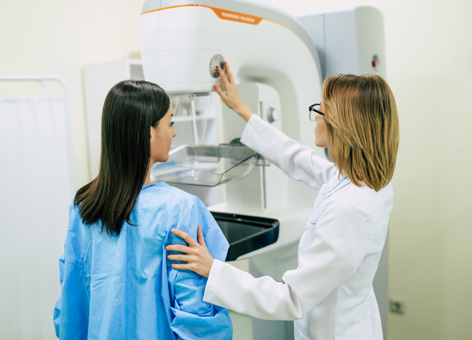You’ve scheduled your mammogram – great work! Here’s information on what to expect during your visit.
Women at average risk for developing breast cancer should begin getting annual mammograms at age 40, and earlier if breast cancer runs in their family. If there is a history of breast cancer in a first-degree relative (i.e. your mother, sister, or grandmother), then you should begin screening 10 years prior to their age at diagnosis or at age 40, whichever comes first.
If there is a history of breast cancer in a first-degree relative, then you should begin screening 10 years prior to their age at diagnosis or at age 40.
When you arrive at the breast center, you’ll check in at the front desk and will be asked for your insurance card if you have one. Before the exam, you’ll be asked to change into a medical gown. The technologist will place radiodense stickers on your skin on top of any moles, scars, or raised skin lesions so the radiologist is aware of them while interpreting your images. This does not hurt at all. It is also important to provide the technologist with your medical history especially pertaining to your breasts.
A mammogram machine is a tall standing structure that uses X-rays to image the breast tissue. The technologist will position your breasts in the mammogram machine and apply compression. The pressure can feel somewhat uncomfortable at first, but you are only required to be in compression for a few seconds at a time while the images are taken. Compression is important because it decreases the radiation dose to the patient and decreases the time to obtain the images.
Once you are in an optimal position, the technologist will leave the room. She will then take multiple images from behind a glass wall. The radiation in a mammogram is very minimal and nearly inconsequential to each patient, however, because the technologist performs this process on many patients throughout the day, she needs to protect herself from the exposure. Once the images are done, your exam is complete.
After the images are taken, your mammogram will be interpreted by a radiologist who will generate a report with the results. The results will include a finding of any new or dominant masses, asymmetries, or calcifications. If a mammogram is completely clear and has no findings to report, that is considered a BI-RADS category 1 or negative. If there are findings to report that are stable or do not require a further evaluation, then it is reported as a category 2 or benign. If there is a finding that needs further evaluation or workup, then it is reported as category 0 for further evaluation.
The radiologist interpreting your images will also evaluate breast density. Breast density is the amount of connective tissue (or fibrous tissue) versus fatty tissue in your breasts. There are four categories of breast density, ranging from category A (fatty or not dense) to D (extremely dense). On the mammogram, the fibrous breast tissue appears gray or white, and fatty tissue appears black or dark gray. The four categories of breast density are:
- Almost entirely fatty
- Scattered fibroglandular density
- Heterogeneously dense
- Extremely dense
The sensitivity of mammograms decreases with increasing breast density. Therefore, supplemental screening with ultrasound or MRI should be considered in those with a category 3 or 4 breast density. After the test, you’ll receive a report in the mail within 30 days or uploaded to your medical portal. The doctor who ordered the mammogram will also receive a copy of the same report. The report will often include information about your breast density, based on your mammogram images. Make sure to learn your breast density and if you have dense breasts, request an ultrasound in addition to your mammogram.
It is very important to keep up with yearly screening exams to maximize your chances of finding cancer early – when it’s most treatable and survival rates are the highest. The most helpful tool for a radiologist when evaluating your mammogram is comparison to prior exams. If you have prior examinations from an outside institution, it is highly recommended to obtain those studies for comparison.
Remember: Annual mammograms are the key to saving lives.
Learn more about defeating breast cancer at The Brem Foundation.













